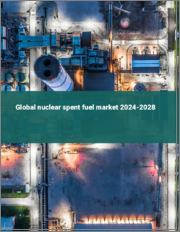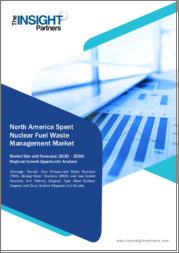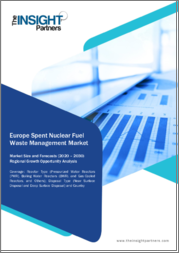
|
시장보고서
상품코드
1454082
사용후핵연료 폐기물 관리 시장 예측(-2030년) : 원자로 유형별, 폐기 유형별, 최종사용자별, 지역별 세계 분석Spent Nuclear Fuel Waste Management Market Forecasts to 2030 - Global Analysis By Reactor Type (Boiling Water Reactor, Pressurized Water Reactor, Gas Cooled Reactor and Other Reactor Type), Disposal Type, End User and By Geography |
||||||
Stratistics MRC에 따르면 세계의 사용후핵연료 폐기물 관리 시장은 2023년에 62억 달러를 차지하고 예측 기간 중 CAGR 3.0%로 성장하며, 2030년에는 77억 달러에 달할 전망입니다.
사용후핵연료(SNF) 폐기물 관리에는 원자로에서 나온 사용후핵연료의 안전한 취급, 보관, 운송 및 처분이 포함됩니다. 이는 원자력 수명주기의 중요한 측면입니다. 현재 사용후핵연료 관리 방법에는 현장 저장과 심지층 처분장 건설이 있습니다. 규제 당국의 승인, 일반 대중의 인식, 장기적인 해결책을 위한 첨단 기술 개발 등의 과제가 있습니다.
청정 에너지원에 대한 수요 증가
원자력을 포함한 청정 에너지원에 대한 수요 증가는 사용후핵연료(SNF) 폐기물 관리 시장에 긍정적인 영향을 미칠 것입니다. 청정 에너지, 특히 원자력에 대한 수요가 증가함에 따라 사용후핵연료 폐기물 관리 시장은 양날의 검에 직면해 있습니다. 수요 증가는 더 많은 폐기물을 생성하고, 더 많은 저장, 운송 및 잠재적 재처리 능력을 필요로 합니다. 그러나 이는 또한 심지층 처분장이나 첨단 재처리 기술과 같은 보다 안전하고 지속가능한 솔루션에 대한 투자를 촉진할 것입니다. 이 시장을 주도하는 것은 증가하는 폐기물의 양을 관리하고 더 엄격한 규제와 사회적 관심의 균형을 맞출 필요가 있기 때문입니다.
엄격한 규제 및 라이선스 요구 사항
높은 규제 준수 기준은 업계 참여자들에게 큰 재정적 부담을 부과하고 폐기물 관리 기술에 대한 투자와 혁신을 저해합니다. 또한 길고 복잡한 규제 승인 절차로 인해 중요한 시설의 설립이 지연되고 솔루션의 적시 시행이 지연되고 있습니다. 또한 엄격한 규제 프레임워크는 불확실성을 증폭시켜 잠재적 투자자들의 의욕을 떨어뜨리고 시장 성장을 제한하고 있습니다.
사용후핵연료 증가
사용후핵연료의 축적은 지속가능한 첨단 폐기물 관리 솔루션에 대한 시급성을 높이고, 저장, 재처리 및 처분 기술의 혁신을 촉진하고 있습니다. 정부 및 업계 이해관계자들은 안전 문제를 해결하고 엄격한 규제를 준수하기 위해 효율적인 관리 전략에 투자해야 합니다. 이러한 비축량 증가는 R&D 구상을 촉진하고 시장 확대에 박차를 가하고 있습니다.
적절한 처분장 부족
사용후핵연료의 적절한 처분장 부재는 폐기물 관리 시장에 큰 도전이 되고 있습니다. 식별되고 승인된 처분장이 없으면 현장 장기 보관의 위험이 높아져 보안과 안전에 대한 우려가 높아집니다. 또한 적절한 처분장의 부재는 프로젝트 계획과 실행의 불확실성과 지연으로 이어져 방사성 폐기물을 책임감 있게 관리할 수 있는 산업계의 능력을 저해합니다. 이러한 진전 부족은 대중의 신뢰를 훼손하고 원자력 에너지와 그 제품별 반대 운동을 악화시킬 수 있습니다.
COVID-19의 영향
공급망 혼란, 노동력 제한, 건설 활동의 제한은 폐기물 관리 시설 개발을 포함한 원자력 프로젝트의 진전을 저해하고 있습니다. 경제 활동 둔화는 정부 예산에도 영향을 미쳐 원자력 계획의 자금 조달에 영향을 미칠 수 있습니다. 또한 팬데믹으로 인해 건강과 안전에 대한 인식이 높아져 원자력 프로젝트에 대한 사회적 인식과 규제 당국의 감독에 영향을 미치고 있습니다.
예측 기간 중 비등수형 원자로 부문이 가장 큰 비중을 차지할 것으로 예상됩니다.
비등수형 원자로 부문은 세계에서 지배적인 원자로 유형인 가압경수로(PWR)에 비해 일반적으로 사용후핵연료 발생량이 다소 적기 때문에 유리한 성장세를 보일 것으로 예상됩니다. 그러나 폐기물의 양 차이는 그리 크지 않아 전체 시장 규모나 성장에 큰 영향을 미치지는 않습니다. 또한 발열량 및 방사능과 같은 BWR 연료의 고유한 특성은 지층 처분장의 요구사항에 영향을 미칠 수 있습니다. 이는 사용후핵연료 관리의 전반적인 전략에 영향을 미칠 수 있습니다.
예측 기간 중 심지층 처분 부문은 가장 높은 CAGR을 나타낼 것으로 예상됩니다.
심지층 처분은 방사성 폐기물을 환경으로부터 격리하는 안전한 방법으로 간주되기 때문에 심지층 처분 부문은 예측 기간 중 가장 높은 CAGR로 성장할 것으로 예상됩니다. 이 방법이 성공적으로 받아들여지고 시행되면 원자력에 대한 사회적 인식이 높아져 사용후핵연료 처리의 장기적인 안전성에 대한 우려가 완화될 수 있습니다. 따라서 이러한 기술을 전문으로 하는 기업은 시장이 심지층 처분 프로젝트에 대한 수요에 적응함에 따라 성장 기회를 얻을 수 있습니다.
가장 큰 점유율을 차지하는 지역 :
아시아태평양은 원자력 발전소 증가로 인해 예측 기간 중 가장 큰 시장 점유율을 차지할 것으로 예상됩니다. 중국, 일본, 인도, 한국은 아시아태평양에서 원자력 발전에 투자하는 주요 국가들입니다. 이들 국가는 사용후핵연료를 안전하고 효율적으로 관리할 수 있는 새로운 기술 개발에 주력하고 있으며, 이는 이 지역 시장 성장을 주도하고 있습니다.
CAGR이 가장 높은 지역 :
북미는 미국과 캐나다가 사용후핵연료 저장 시설을 설립함에 따라 예측 기간 중 가장 높은 CAGR을 보일 것으로 예상됩니다. 미국에서는 네바다주의 유카 마운틴 처분장이 장기 저장 솔루션으로 제안되었지만, 그 개발은 다양한 도전과 논쟁에 직면했습니다. 또한 방사성 폐기물 관리에 대한 규제 프레임워크도 필수적인 요소입니다. 미국 원자력규제위원회(NRC)와 캐나다 원자력안전위원회(CNSC)는 사용후핵연료 관리를 포함한 원자력 활동을 규제하고 감독하는 데 중요한 역할을 하고 있습니다.
무료 커스터마이징 제공:
이 보고서를 구독하는 고객은 다음과 같은 무료 맞춤화 옵션 중 하나를 사용할 수 있습니다. :
- 기업 개요
- 추가 시장 기업의 종합적인 프로파일링(최대 3개사)
- 주요 기업의 SWOT 분석(최대 3개사)
- 지역 세분화
- 고객의 관심에 따른 주요 국가별 시장 추정치, 예측, CAGR(주: 타당성 확인에 따라 다름)
- 경쟁사 벤치마킹
- 제품 포트폴리오, 지역적 입지, 전략적 제휴를 기반으로 한 주요 기업 벤치마킹
목차
제1장 주요 요약
제2장 서문
- 개요
- 이해관계자
- 조사 범위
- 조사 방법
- 데이터 마이닝
- 데이터 분석
- 데이터 검증
- 조사 어프로치
- 조사 소스
- 1차 조사 소스
- 2차 조사 소스
- 전제조건
제3장 시장 동향 분석
- 촉진요인
- 억제요인
- 기회
- 위협
- 최종사용자 분석
- 신흥 시장
- 신종 코로나바이러스 감염증(COVID-19)의 영향
제4장 Porter's Five Forces 분석
- 공급 기업의 교섭력
- 구매자의 교섭력
- 대체품의 위협
- 신규 진출업체의 위협
- 경쟁 기업간 경쟁 관계
제5장 세계의 사용후핵연료 폐기물 관리 시장 : 원자로 유형별
- 비등수형 원자로
- 가압수형 원자로
- 가스냉각로
- 기타 원자로 유형
제6장 세계의 사용후핵연료 폐기물 관리 시장 : 폐기 유형별
- 심층 폐기
- 지표 표면 폐기
제7장 세계의 사용후핵연료 폐기물 관리 시장 : 최종사용자별
- 연구 및 의료기관
- 원자력발전소
제8장 세계의 사용후핵연료 폐기물 관리 시장 : 지역별
- 북미
- 미국
- 캐나다
- 멕시코
- 유럽
- 독일
- 영국
- 이탈리아
- 프랑스
- 스페인
- 기타 유럽
- 아시아태평양
- 일본
- 중국
- 인도
- 호주
- 뉴질랜드
- 한국
- 기타 아시아태평양
- 남미
- 아르헨티나
- 브라질
- 칠레
- 기타 남미
- 중동 및 아프리카
- 사우디아라비아
- 아랍에미리트
- 카타르
- 남아프리카공화국
- 기타 중동 및 아프리카
제9장 주요 발전
- 계약, 파트너십, 협업, 합병사업
- 인수합병
- 신제품의 발매
- 사업 확대
- 기타 주요 전략
제10장 기업 개요
- Veolia Environnement S.A.
- Holtec International
- Waste Control Specialists LLC
- Perma-Fix Environmental Services, Inc.
- Bechtel Group
- Nuclear Fuel Services, Inc.
- Augean PLC
- BHI Energy
- Svensk Karnbranslehantering AB
- US Ecology Inc
- Ansaldo Energia SPA
- EnergySolutions
According to Stratistics MRC, the Global Spent Nuclear Fuel Waste Management Market is accounted for $6.2 billion in 2023 and is expected to reach $7.7 billion by 2030 growing at a CAGR of 3.0% during the forecast period. Spent Nuclear Fuel (SNF) Waste Management involves the safe handling, storage, transportation, and disposal of used nuclear fuel from reactors. It is a critical aspect of the nuclear energy lifecycle. Current methods include on-site storage and research on deep geological repositories. Challenges include regulatory approvals, public perception, and developing advanced technologies for long-term solutions.
Market Dynamics:
Driver:
Increasing demand for clean energy sources
The increasing demand for clean energy sources, including nuclear power, positively impacts the Spent Nuclear Fuel (SNF) Waste Management Market. As the need for clean energy grows, particularly nuclear power, the spent nuclear fuel waste management market faces a double-edged sword. The rising demand generates more waste, requiring increased storage, transportation, and potentially reprocessing capabilities. However, this also fuels investment in safer and more sustainable solutions like deep geological repositories and advanced reprocessing techniques. This market will be driven by the need to balance managing the growing waste volume with stricter regulations and public concerns.
Restraint:
Stringent regulations and licensing requirements
The high compliance standards impose substantial financial burdens on industry participants, hindering investment and innovation in waste management technologies. Moreover, the lengthy and complex regulatory approval processes delay the establishment of critical facilities, impeding the timely implementation of solutions. Moreover, the rigid regulatory framework amplifies uncertainties, discouraging potential investors and limiting the growth of the market.
Opportunity:
Growing stockpile of spent nuclear fuel
The accumulation of SNF heightens the urgency for advanced and sustainable waste management solutions, fostering innovation in storage, reprocessing, and disposal technologies. Governments and industry stakeholders are compelled to invest in efficient management strategies to address safety concerns and comply with stringent regulations. This growing stockpile propels research and development initiatives, spurring market expansion.
Threat:
Lack of suitable disposal sites
The lack of suitable disposal sites for spent nuclear fuel poses significant challenges for the waste management market. Without identified and approved repositories, there is a heightened risk of prolonged onsite storage, increasing security and safety concerns. The absence of suitable sites also leads to uncertainty and delays in project planning and execution, inhibiting the industry's ability to responsibly manage radioactive waste. This lack of progress can erode public trust, exacerbating opposition to nuclear energy and its by-products.
Covid-19 Impact
Disruptions in supply chains, workforce limitations, and restrictions on construction activities have hindered the progress of nuclear projects, including the development of waste management facilities. The slowdown in economic activities has also affected government budgets, potentially influencing funding for nuclear programs. Moreover, the pandemic has heightened awareness of health and safety considerations, impacting public perception and regulatory scrutiny of nuclear projects.
The boiling water reactor segment is expected to be the largest during the forecast period
The boiling water reactor segment is estimated to have a lucrative growth, because generally produce slightly less spent nuclear fuel compared to pressurized water reactors (PWRs), the dominant reactor type globally. However, the difference in waste volume is not substantial and doesn't significantly impact the overall market size or growth. Moreover the specific characteristics of BWR fuel, such as its heat generation and radioactivity, can impact the requirements for geological repositories. This, in turn, may influence the overall strategy for spent fuel management.
The deep surface disposal segment is expected to have the highest CAGR during the forecast period
The deep surface disposal segment is anticipated to witness the highest CAGR growth during the forecast period, as deep geological disposal is considered a safe method for isolating radioactive waste from the environment. If this method gains acceptance and is successfully implemented, it may enhance public perception of nuclear energy and reduce concerns related to the long-term safety of spent fuel disposal. Thus companies specializing in these technologies may experience growth opportunities as the market adapts to the demands of deep surface disposal projects.
Region with largest share:
Asia Pacific is projected to hold the largest market share during the forecast period owing to the increasing number of nuclear power plants in the region. China, Japan, India, and South Korea are the major countries in the Asia Pacific region that are investing in nuclear power generation. These countries are also focusing on developing new technologies for the safe and efficient management of spent nuclear fuel driving the growth of the market in this region.
Region with highest CAGR:
North America is projected to have the highest CAGR over the forecast period, owing to the United States and Canada established storage facilities for spent nuclear fuel. In the U.S., the Yucca Mountain repository in Nevada was proposed as a long-term storage solution, but its development faced various challenges and controversies. Moreover the regulatory framework for nuclear waste management is an essential aspect. The U.S. Nuclear Regulatory Commission (NRC) and the Canadian Nuclear Safety Commission (CNSC) play crucial roles in regulating and overseeing nuclear activities, including spent fuel management.
Key players in the market
Some of the key players in the Spent Nuclear Fuel Waste Management Market include Veolia Environnement S.A., Holtec International, Waste Control Specialists LLC, Perma-Fix Environmental Services, Inc., Bechtel Group, Nuclear Fuel Services, Inc., Augean PLC, BHI Energy, Svensk Karnbranslehantering AB, US Ecology Inc, Ansaldo Energia SPA, and EnergySolutions,
Key Developments:
In March 2024, Veolia unveiled its new strategic program, GreenUp, for 2024-2027. The program's goal is to become the link missing in ecological transformation by greening and deploying replicable solutions that depollute, decarbonize, and regenerate resources.
In February 2024, Veolia launches its new strategic plan to accelerate ecological transformation to meet growing global demand. Their rapid, large-scale deployment will help erasing 18 million tons of Scope 43 CO2 emissions by 2027 and preserve 1.5 billion m3 of water.
In January 2023, Waste Control Specialists launches bilingual website. This is the latest move in WCS' effort to re-engage with the community and maintain a productive dialogue with neighbors and interested parties.
Reactor Types Covered:
- Boiling Water Reactor
- Pressurized Water Reactor
- Gas Cooled Reactor
- Other Reactor Type
Disposal Types Covered:
- Deep Surface Disposal
- Near Surface Disposal
End Users Covered:
- Research & Medical Institutions
- Nuclear Power Plants
Regions Covered:
- North America
- US
- Canada
- Mexico
- Europe
- Germany
- UK
- Italy
- France
- Spain
- Rest of Europe
- Asia Pacific
- Japan
- China
- India
- Australia
- New Zealand
- South Korea
- Rest of Asia Pacific
- South America
- Argentina
- Brazil
- Chile
- Rest of South America
- Middle East & Africa
- Saudi Arabia
- UAE
- Qatar
- South Africa
- Rest of Middle East & Africa
What our report offers:
- Market share assessments for the regional and country-level segments
- Strategic recommendations for the new entrants
- Covers Market data for the years 2021, 2022, 2023, 2026, and 2030
- Market Trends (Drivers, Constraints, Opportunities, Threats, Challenges, Investment Opportunities, and recommendations)
- Strategic recommendations in key business segments based on the market estimations
- Competitive landscaping mapping the key common trends
- Company profiling with detailed strategies, financials, and recent developments
- Supply chain trends mapping the latest technological advancements
Free Customization Offerings:
All the customers of this report will be entitled to receive one of the following free customization options:
- Company Profiling
- Comprehensive profiling of additional market players (up to 3)
- SWOT Analysis of key players (up to 3)
- Regional Segmentation
- Market estimations, Forecasts and CAGR of any prominent country as per the client's interest (Note: Depends on feasibility check)
- Competitive Benchmarking
- Benchmarking of key players based on product portfolio, geographical presence, and strategic alliances
Table of Contents
1 Executive Summary
2 Preface
- 2.1 Abstract
- 2.2 Stake Holders
- 2.3 Research Scope
- 2.4 Research Methodology
- 2.4.1 Data Mining
- 2.4.2 Data Analysis
- 2.4.3 Data Validation
- 2.4.4 Research Approach
- 2.5 Research Sources
- 2.5.1 Primary Research Sources
- 2.5.2 Secondary Research Sources
- 2.5.3 Assumptions
3 Market Trend Analysis
- 3.1 Introduction
- 3.2 Drivers
- 3.3 Restraints
- 3.4 Opportunities
- 3.5 Threats
- 3.6 End User Analysis
- 3.7 Emerging Markets
- 3.8 Impact of Covid-19
4 Porters Five Force Analysis
- 4.1 Bargaining power of suppliers
- 4.2 Bargaining power of buyers
- 4.3 Threat of substitutes
- 4.4 Threat of new entrants
- 4.5 Competitive rivalry
5 Global Spent Nuclear Fuel Waste Management Market, By Reactor Type
- 5.1 Introduction
- 5.2 Boiling Water Reactor
- 5.3 Pressurized Water Reactor
- 5.4 Gas Cooled Reactor
- 5.5 Other Reactor Type
6 Global Spent Nuclear Fuel Waste Management Market, By Disposal Type
- 6.1 Introduction
- 6.2 Deep Surface Disposal
- 6.3 Near Surface Disposal
7 Global Spent Nuclear Fuel Waste Management Market, By End User
- 7.1 Introduction
- 7.2 Research & Medical Institutions
- 7.3 Nuclear Power Plants
8 Global Spent Nuclear Fuel Waste Management Market, By Geography
- 8.1 Introduction
- 8.2 North America
- 8.2.1 US
- 8.2.2 Canada
- 8.2.3 Mexico
- 8.3 Europe
- 8.3.1 Germany
- 8.3.2 UK
- 8.3.3 Italy
- 8.3.4 France
- 8.3.5 Spain
- 8.3.6 Rest of Europe
- 8.4 Asia Pacific
- 8.4.1 Japan
- 8.4.2 China
- 8.4.3 India
- 8.4.4 Australia
- 8.4.5 New Zealand
- 8.4.6 South Korea
- 8.4.7 Rest of Asia Pacific
- 8.5 South America
- 8.5.1 Argentina
- 8.5.2 Brazil
- 8.5.3 Chile
- 8.5.4 Rest of South America
- 8.6 Middle East & Africa
- 8.6.1 Saudi Arabia
- 8.6.2 UAE
- 8.6.3 Qatar
- 8.6.4 South Africa
- 8.6.5 Rest of Middle East & Africa
9 Key Developments
- 9.1 Agreements, Partnerships, Collaborations and Joint Ventures
- 9.2 Acquisitions & Mergers
- 9.3 New Product Launch
- 9.4 Expansions
- 9.5 Other Key Strategies
10 Company Profiling
- 10.1 Veolia Environnement S.A.
- 10.2 Holtec International
- 10.3 Waste Control Specialists LLC
- 10.4 Perma-Fix Environmental Services, Inc.
- 10.5 Bechtel Group
- 10.6 Nuclear Fuel Services, Inc.
- 10.7 Augean PLC
- 10.8 BHI Energy
- 10.9 Svensk Karnbranslehantering AB
- 10.10 US Ecology Inc
- 10.11 Ansaldo Energia SPA
- 10.12 EnergySolutions



















